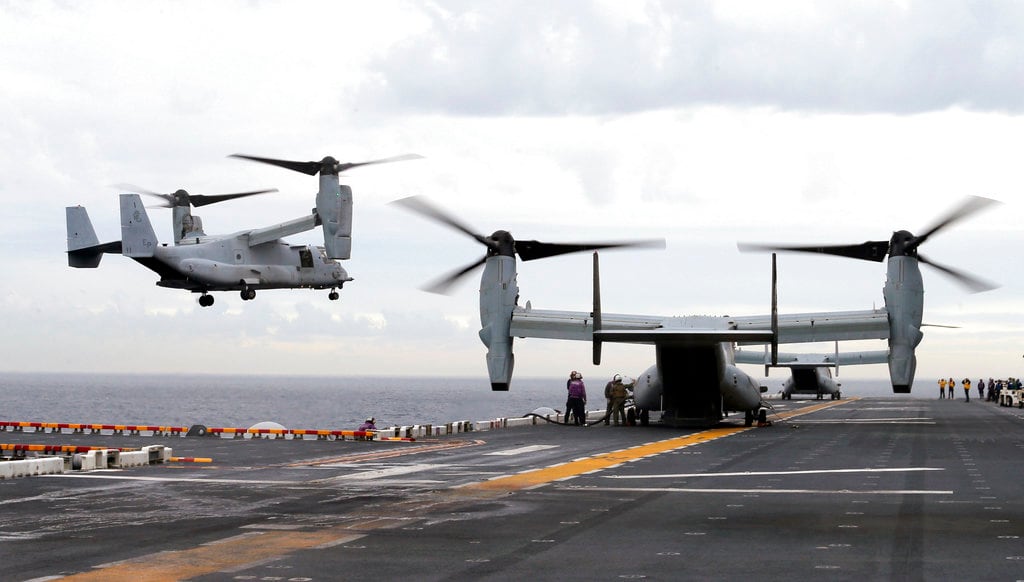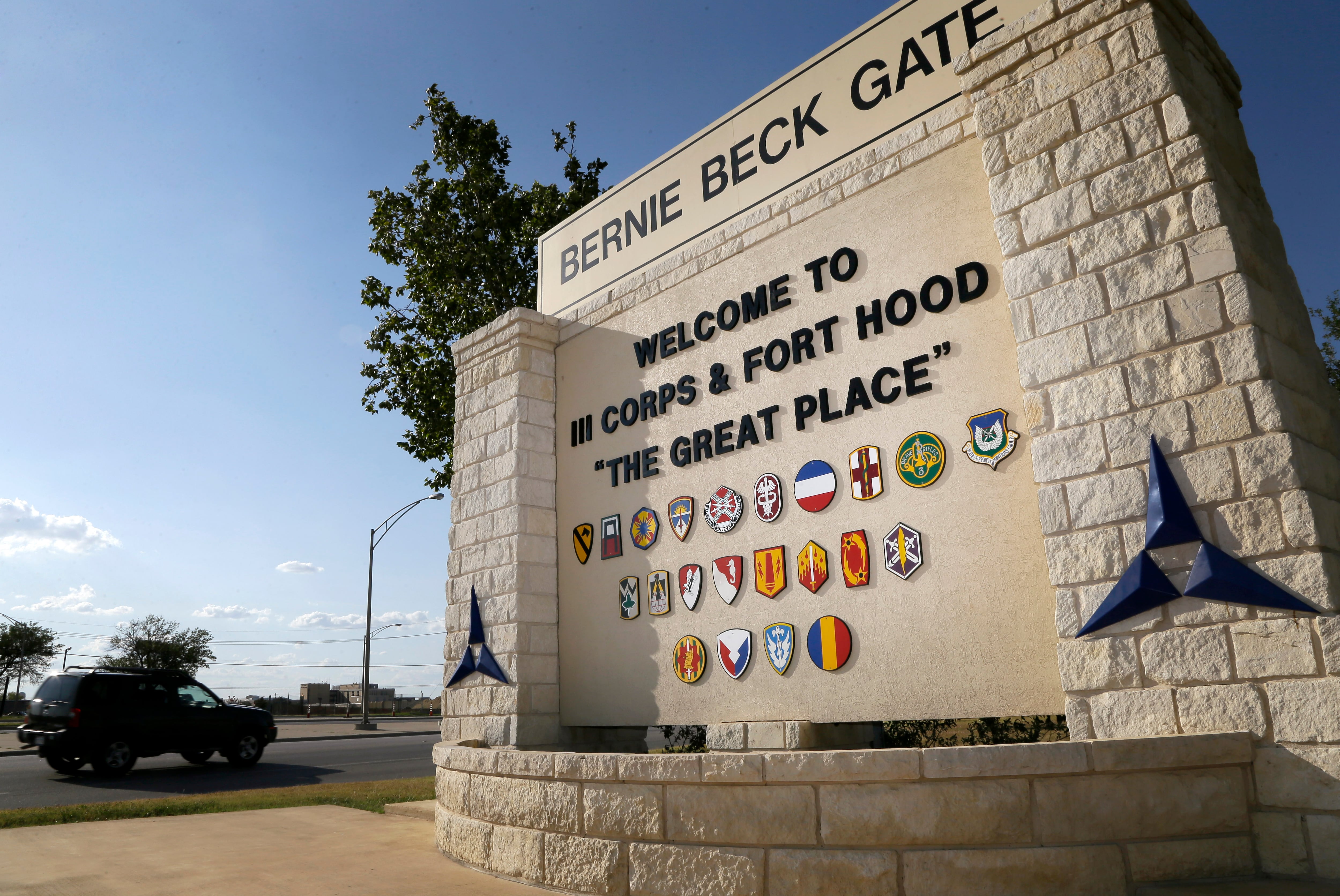A heart-wrenching video surfaced recently showing the final minutes of a 2017 fatal MV-22 Osprey crash that killed three Marines and injured another 23 during an exercise off the coast of Queensland, Australia.
The two minutes and 28 seconds of the video that shows the Osprey landing-turned crash aboard the amphibious transport dock Green Bay on Aug. 5, 2017, was posted on the YouTube channel “What You Haven’t Seen” on July 2. As of Tuesday, it had been viewed nearly five million times.
The first minute of the 8-minute 45-second post shows the aircraft approach, being guided by flight deck personnel before it dips, striking the deck and then falling into the ocean. Footage later on says to be of the wreckage being recovered from the sea.
An investigation found no pilot error in the 2017 crash, instead attributing the event to potential downwash and insufficient power. Officials at the time said that those problems were analyzed and appropriate corrections incorporated across the Osprey fleet.
RELATED

Marine officials could not “confirm the origins of the video or tie it directly” to the 2017 fatal crash, but “it appears to be consistent with the command investigation,” Marine Maj. Jorge Hernandez, spokesman for Marine aviation, wrote in an email response to Marine Corps Times.
Hernandez wrote that the entire Marine aviation community continues to refine all elements of MV-22 operations and use, “specifically applying lessons learned from previous mishaps.”
Several media outlets have noted the history of the Osprey and fatal crashes and nonfatal mishaps. Since initial flights in 1989 with prototype aircraft, at least 51 military members have died in connection with mishaps or crashes involving the Osprey.
Hernandez provided larger context regarding data on Marine aviation, noting that only in the past decade the aircraft has flown more than 420,000 flight hours, more than half of that in the past five years.
“The 10-year average mishap rate for MV-22′s is 3.16 per 100,000 flight hours,” Hernandez wrote on July 8.
For comparison, that rate is lower than the AV-8 Harrier jet, variants of the F/A-18 Super Hornet, the F-35B fighter jet and the CH-53E Super Stallion. The 3.16 Osprey mishap rate is near the total Marine aviation platform average of 3.1 per 100,000 flight hours, the major wrote.
The Osprey aircraft, Hernandez wrote, flies nearly double the hours of the Corps’ other rotary wing platforms. The major called the aircraft the “workhorse” of the service’s assault support community, with capabilities far exceeding the CH-46, which it has supplanted for most missions.
On Aug. 5, 2017, the day of the Queensland Osprey crash, the crew had worked in a three-aircraft group simulating mass casualty drills, logistics movements, noncombat evacuations and embassy reinforcements, according to the investigation.
The crew had flown that day from the amphibious assault ship Bonhomme Richard (LHD-6) to the Australian shore, back to refuel at the Bonhomme Richard, then to the dock landing ship Ashland to drop off cargo and a passenger, back to the Bonhomme Richard for the mass casualty drill, taking those passengers ashore, returning with more passengers to the Bonhomme Richard, followed by another trip ashore for the noncombat evacuation pickup then heading to the Green Bay.
The pilot, a Marine major not identified in the report but who survived the crash, attempted to correct a 200-foot to 300-foot rate of descent using the machine’s thrust control lever, according to the investigation. But the pilot could not stop the quick descent and made adjustments. The left outer engine casing hit the flight deck, driving the aircraft forward and into a steel stairway on the starboard side of the flight deck.
The impact crushed the plane’s cockpit, breaking the hip and leg of the pilot. The Osprey fell 30 feet into the ocean, filling quickly with water before sinking nose-first, according to the investigation.
Shortly following the incident, the Marine Corps identified the Marines killed in the crash as:
- 1st Lt. Benjamin R. Cross, 26, of Oxford, Maine, assigned to Marine Medium Tiltrotor Squadron 265. Cross was posthumously promoted to captain.
- Cpl. Nathaniel F. Ordway, 21, of Sedgwick, Kansas, assigned to Marine Medium Tiltrotor Squadron 265.
- Pfc. Ruben P. Velasco, 19 of Los Angeles, assigned to Battery G, Battalion Landing Team, 3rd Battalion, 5th Marines.
In 2018 the Marine Corps released an investigation that noted that the aircraft was facing too much “downwash” and did not have enough thrust or power to maintain its hovering before the landing. Navy engineers subsequently reviewed the effect of downwash on aircraft such as the Osprey, examining the power the rotary wing plane required to defeat the downwash effect.
Downwash is air deflected around the rotor or plane’s wing when in operation.
There have been two recent, high-profile fatal Osprey crashes.
On June 8, five Marines died when an Osprey crashed during routine training near Glamis, California. Off the coast of Norway on March 17, four Marines died in an Osprey crash at sea.
Victims of the June crash in California, which included members of Marine Medium Tilt-rotor (VMM) Squadron 364, Marine Aircraft Group 39, 3rd Marine Aircraft Wing, out of Camp Pendleton, California, were identified following family notifications:
- Lance Cpl. Evan A. Strickland, 19, of Valencia, New Mexico, tilt-rotor crew chief.
- Cpl. Nathan E. Carlson, 21, of Winnebago, Illinois, tilt-rotor crew chief.
- Cpl. Seth D. Rasmuson, 21, of Johnson, Wyoming, tilt-rotor crew chief.
- Capt. John J. Sax, 33, of Placer, California, an MV-22B pilot.
- Capt. Nicholas P. Losapio, 31, of New Durham, New Hampshire, an MV-22B pilot.
Victims of the March crash near Norway included:
- Capt. Ross A. Reynolds, 27, of Leominster, Massachusetts.
- Capt. Matthew J. Tomkiewicz, 27, of Fort Wayne, Indiana.
- Gunnery Sgt. James W. Speedy, 30, of Cambridge, Ohio.
- Cpl. Jacob M. Moore, 24, of Catlettsburg, Kentucky.
Both crashes remain under investigation.
Following the June crash, the Marine Corps issued a safety standdown for all aviation units between June 21 and July 1.
The Corps had experienced six class-A mishaps since January 2022 that had resulted in nine fatalities and the destruction of four aircraft, the official Marine administrative message noted. The two other aircraft mishaps did not sustain fatalities.
The standdown focused on reinforcing proper procedures, providing information and gathering feedback, according to the message.
Note: This article has been updated to include information regarding the posthumous promotion of 1st. Lt. Benjamine Cross to captain.
Todd South has written about crime, courts, government and the military for multiple publications since 2004 and was named a 2014 Pulitzer finalist for a co-written project on witness intimidation. Todd is a Marine veteran of the Iraq War.




